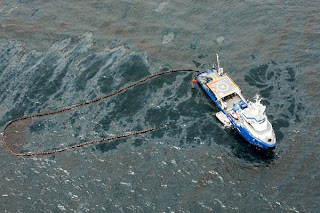Plumes of Gulf oil spreading east on sea floor
 CNN reports: A new report set to be released today renews concerns about the long-term environmental impact of the Gulf Coast oil disaster.
CNN reports: A new report set to be released today renews concerns about the long-term environmental impact of the Gulf Coast oil disaster.Researchers at the University of South Florida have concluded that oil from the Deepwater Horizon spill may have settled to the bottom of the Gulf of Mexico further east than previously suspected -- and at levels toxic to marine life.
Initial findings from a new survey of the Gulf conclude that dispersants may have sent droplets of crude to the ocean floor, where it has turned up at the bottom of an undersea canyon within 40 miles of the Florida Panhandle.
Plankton and other organisms at the base of the food chain showed a "strong toxic response" to the crude, and the oil could well up onto the continental shelf and resurface later, according to researchers.
"The dispersant is moving the oil down out of the surface and into the deeper waters, where it can affect phytoplankton and other marine life," said John Paul, a marine microbiologist at USF.
Meanwhile, retired Coast Guard Adm. Thad Allen, the federal government's point man in the Gulf, said yesterday that attempts to permanently seal the well won't start until the latest potential problem is evaluated. Allen said engineers are now concerned about how to manage the risk of pressure in the annulus, a ring that surrounds the casing pipe at the center of the well shaft.
The "timelines won't be known until we get a recommendation on the course of action," Allen said.
Scientists began new pressure tests last week to gauge the effects of the mud and cement poured into the well from above during the "static kill" procedure that started August 3. From those pressure readings, they believe that either some of the cement breached the casing pipe and leaked into the annulus, or cement came up into the annulus from the bottom.
The scientists believe that process may have trapped some oil between the cement and the top of the well, inside the annulus. Now, given that new variable, they're trying to figure out how to safely maintain the pressure within the well before launching the "bottom kill," a procedure aimed at sealing the well from below.
Meanwhile, retired Coast Guard Adm. Thad Allen, the federal government's point man in the Gulf, said yesterday that attempts to permanently seal the well won't start until the latest potential problem is evaluated. Allen said engineers are now concerned about how to manage the risk of pressure in the annulus, a ring that surrounds the casing pipe at the center of the well shaft.
The "timelines won't be known until we get a recommendation on the course of action," Allen said.
Scientists began new pressure tests last week to gauge the effects of the mud and cement poured into the well from above during the "static kill" procedure that started August 3. From those pressure readings, they believe that either some of the cement breached the casing pipe and leaked into the annulus, or cement came up into the annulus from the bottom.
The scientists believe that process may have trapped some oil between the cement and the top of the well, inside the annulus. Now, given that new variable, they're trying to figure out how to safely maintain the pressure within the well before launching the "bottom kill," a procedure aimed at sealing the well from below.



Comments